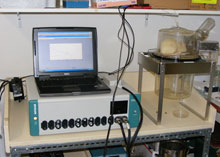Power from Glucose
Scientists have implanted the first functional glucose biofuel cell in a living animal. Unlike batteries that supply power to implants, a power-generating device may not have to be surgically removed and replaced, because glucose is a potentially limitless source of energy.

The device uses enzymes to harvest energy from glucose and oxygen found naturally in the body. Past attempts at using such a device in animals have failed because the enzymes have required acidic conditions or were inhibited by charged particles in the fluid surrounding cells. But Philippe Cinquin and his team from Joseph Fourier University in Grenoble, France, overcame these obstacles by confining selected enzymes inside graphite discs that were placed into dialysis bags. Glucose and oxygen flowed into the device, but enzymes stayed in place and catalyzed the oxidation of glucose to generate electrical energy.
The team surgically implanted the device in the abdominal cavity of two rats. The maximum power of the device was 6.5 microwatts, which approaches the 10 microwatts required by pacemakers. The power remained around two microwatts for 11 days in one rat, and the other rat showed byproducts of glucose oxidation in its urine for three months, indicating that the device lasts at least that long. “This is a big breakthrough for the field of implantable biofuel cells,” says Shelley Minteer, an electrochemist at Saint Louis University.
“It’s quite an interesting paper that demonstrates for the first time that one can generate electrical power from body fluids,” says Itamar Willner, a biomolecular chemist at the Hebrew University of Jerusalem.
The technology could be used for a range of applications, such as neural and bone-growth stimulators, drug delivery devices, insulin pumps, and biosensors, says Eileen Yu, a chemical engineer at Newcastle University. But whether enzymes remain stable for a long period of time is a concern, she says. And the efficiency of transfer of electrons between enzymes and electrodes should be improved, she says.
Cinquin believes his team can improve its efficiency. “I’m optimistic that we will get tens of milliwatts in future versions,” he says.
The authors would next like to test the device for longer periods of time in larger animals, improve its design, and incorporate biocompatible materials. “If industry finds a willingness to enter into the technological development of biofuel cells, I’m sure the use of biofuel cells to power medical implants will materialize in a very short period of time,” Willner says.
Keep Reading
Most Popular
Large language models can do jaw-dropping things. But nobody knows exactly why.
And that's a problem. Figuring it out is one of the biggest scientific puzzles of our time and a crucial step towards controlling more powerful future models.
How scientists traced a mysterious covid case back to six toilets
When wastewater surveillance turns into a hunt for a single infected individual, the ethics get tricky.
The problem with plug-in hybrids? Their drivers.
Plug-in hybrids are often sold as a transition to EVs, but new data from Europe shows we’re still underestimating the emissions they produce.
Google DeepMind’s new generative model makes Super Mario–like games from scratch
Genie learns how to control games by watching hours and hours of video. It could help train next-gen robots too.
Stay connected
Get the latest updates from
MIT Technology Review
Discover special offers, top stories, upcoming events, and more.